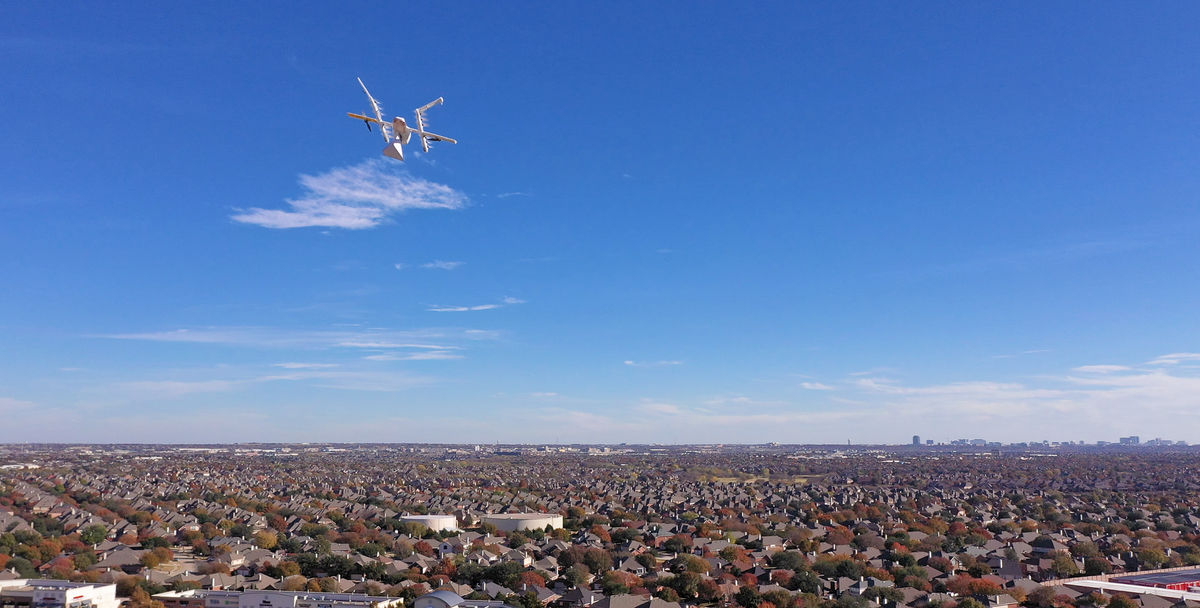There are all kinds of things that you can do with robots. This, in some sense, is a problem with robots—just because some task or problem can be solved with robots does not necessarily mean that task or problem should be solved with robots.
Is suburban drone delivery of consumer goods one of these things? Wing (a subsidiary of Alphabet) is determined to prove that drone delivery can work and has absolutely made it work, recently completing 200,000 deliveries in Australia and following that up with an expansion into a community in Texas, launching this month. Does this conclusively prove that there’s demand and Wing’s business model is realistic and sustainable? Maybe. But probably not.
Honestly, if I forget to pick up a loaf of bread at the grocery store, is the best solution really to have this enormously complex and expensive delivery-drone infrastructure in place to get me that loaf of bread? Or a single apple? Yeah, that’s just the PR video, but it’s in line with how Wing advertises its services.
As we have reported in the past, drone delivery definitely has value. I feel like that value is when you have time-critical, very high value things that cannot be delivered efficiently any other way. In those cases, send in the drones. Medications and vaccines are the classic example. But seeing a drone deliver an apple makes me wince a little bit, because it feels a little too much like using this amazing technology simply for its own sake, rather than for a practical, viable reason.
I do want to acknowledge that getting goods (including food) to people is an important task, and a task that robots are well qualified for. I totally want my groceries to be delivered by robot, but rarely do my groceries consist of a single apple, and even more rarely do I have a desperate need for an apple right now. And there are other ways of solving the last mile (or last several miles) problem, whether it’s sidewalk robots or autonomous cars, both of which have the potential to carry much more cargo much farther than a drone can, making them (I would argue) more broadly useful, especially in a suburban setting.
It’s true that drone delivery is unique in that it’s fast and direct, and there are times when that’s necessary. It’s also true that sidewalk robots and larger autonomous vehicles have their own problems, many of which can be circumvented with drones. I think that the place for consumer delivery drones is as part of a broader robotic delivery ecosystem, with different kinds of robots doing the tasks that they are best suited for. Does that ecosystem exist yet? No. Is Wing helping us get closer to that ecosystem? Almost definitely. Should our long-term expectation be that whenever we want an apple or a taco or a cup of coffee, a drone will bring it to us in 10 minutes or less because that’s the best way for our desires to be fulfilled? Honestly, I kind of hope not.
What Wing has done in Australia and will continue to do in Texas proves that suburban drone delivery can work in the sense that it can function from a technical perspective, which is no small feat. The hardware, the software, the infrastructure, operating at scale for years—that’s all incredibly impressive, and I’m not trying to minimize those achievements. But, it doesn’t necessarily prove that a problem is being solved either efficiently or sustainably, especially relative to other ways of solving similar problems, and it’s also not clear just how much Wing is subsidizing the cost of all of this, and what its long-term business plan is.

If we now assume that Wing at least has a good handle on the technical challenges surrounding suburban drone delivery (even if it hasn’t solved them completely), that still leaves three big questions. First, does this massive investment of time and money and engineering talent from Wing actually translate into a business model that’s profitable long-term? Second, are small drones carrying up to 1.2 kilograms of cargo at a time really the best way of solving the problem of getting goods to the people that need them in a timely manner? And third, even if suburban delivery drones can fulfill this role, should they? Is Wing using its resources and world-class engineering expertise to leverage robotics into creatively solving real-world problems, or is it instead using the inherent novelty of drone delivery to justify a bonkers amount of infrastructure just to get a select group of people single items of food on demand?
For its part, Wing did make this comment in a recent blog post:
Integrating drone delivery into daily life isn’t just an added convenience. It holds the promise to reduce traffic congestion, accidents, and greenhouse gas emissions while growing sales for businesses all the while giving people more time back in their busy lives.
Those are big, important promises. I sincerely hope Wing can deliver.
Evan Ackerman is a senior editor at IEEE Spectrum. Since 2007, he has written over 6,000 articles on robotics and technology. He has a degree in Martian geology and is excellent at playing bagpipes.



